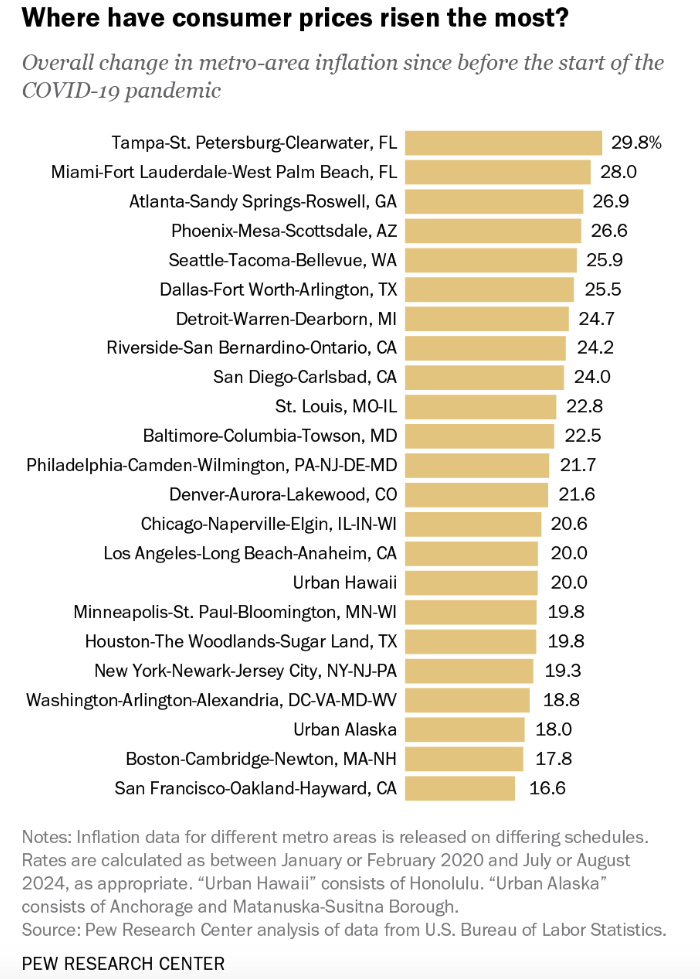Inflation is increasing less, but prices are still high. Very high.
And you know where the job growth is, right?
Here are some job numbers and inflation numbers.
Inflation in the U.S. dropped from a 9.1% growth rate in June 2022 to 2.5% in August 2024. That may sound like good news, but there is terrible news—prices are still high and will likely stay that way unless a recession hits.
Since January 2020, before COVID-19 messed up the economy, prices have risen by 22%. Now, a Pew Research survey says 74% of Americans are apprehensive about the cost of food and consumer goods, and 69% are stressed about housing costs. The present is bleak, and the future is more dismal.
Of course, inflation hits everyone differently depending on where they live and what they buy. Prices for apartments in Atlanta, bananas in Boston, or sportswear in Seattle all add up to the national inflation rate, but everyone’s experience is unique.
And the soft underbelly few talk about is jobs –
Recent data on U.S. job growth in the third quarter of 2024 shows a robust labor market, with 254,000 jobs added in September alone. But let us not get too excited just yet as we remember the 800,000 plus corrections recently to clean up the “over-reporting” of new jobs.
And yes, the hits keep coming since recent migrants have filled a significant portion of these jobs. Since 2022, an influx of 5.9 million migrants has contributed substantially to filling labor gaps, particularly in lower-wage industries. Many of these workers have found employment in sectors such as agriculture, construction, healthcare, and hospitality, all critical areas experiencing labor shortages.
For example, immigrants now make up 27.7% of health aides and nearly half of all agricultural laborers. These workers have helped meet the high demand for services, especially in fields that U.S.-born workers have increasingly avoided. In construction, one in four workers is an immigrant, with this share being even higher in states like California and Texas, where housing shortages are severe.
Additionally, many migrants, including undocumented workers, are contributing to the labor market, helping to ease shortages without driving significant wage inflation. This wave of migration has balanced out the job market, even as many U.S.-born individuals leave the workforce. While these migrant workers help stabilize the economy, concerns remain about long-term wage growth and the sustainability of this employment trend.
The participation of low-income migrant workers has been essential in keeping certain sectors functional while contributing to the overall job growth numbers, but it raises questions about wage levels and economic inclusivity moving forward.
And did you think there was no more bad news hidden in these numbers? Wrong!
Despite these gains, the number of people leaving the labor market, such as those who are discouraged or marginally attached to the workforce, has seen an increase. This trend suggests that while job growth remains strong, not everyone is participating equally in the recovery.
The unemployment rate fell slightly to 4.1%, reflecting solid hiring but also raising concerns about whether this pace can be sustained without inflationary pressures. As more people leave the workforce, the labor participation rate has not fully rebounded, complicating the picture of true economic growth(
These are government statistics, but most are feeling the pinch every time they go to the supermarket, pay rent, fill up their car, and grab a bite to eat.
On a political note, the folks who are promising change now were the ones in charge these past 3 and a half years. Promises with no performance history are not going to pay the bills. And where were these actions to fix what they broke these past years? A platform is what you run on to get elected, but run from once in office.
